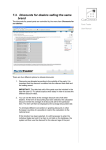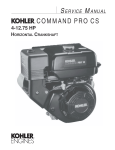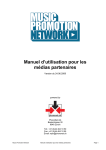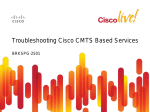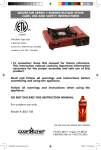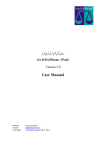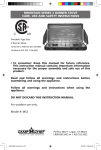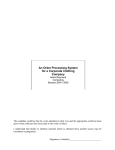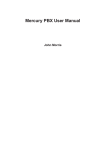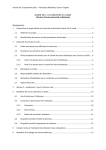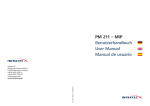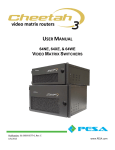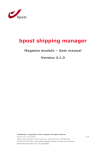Download 1.0. Overview IntraSys is the standard interface between
Transcript
IntrasysE 1.0. Overview IntraSys is the standard interface between the central PhonoNet system and industry / company users. file:///C|/test%20phono%20web/downloads/intrasyse.htm (1 of 16) [30-10-2003 11:46:34] IntrasysE The functionalities of IntraSys are: • Secure data communication with the PhonoNet (Webster) network • EDIFACT based data exchange with PhonoNet (orders, catalogue updates) • Import from and export to in-house applications by means of flat SDF files • Creation of catalogue updates through comparison of catalogue files • Collection of orders from the central PhonoNet system • Table driven translation of internal (in-house) codes into PhonoNet standard codes • Timer controlled, external controlled or manual operating Internal tables in IntraSys • Catalogue (product database) • Order database • Translation tables for • Article status codes • Supplier codes • Genre codes • (sound-)Carrier (configuration-) codes • Label codes In most cases the implementation of an IntraSys system is a simple procedure and will be fully supported by PhonoNet. In some cases a company-specific subroutine needs to be build and integrated into IntraSys to translate in-house article codes into standard PhonoNet formatted article codes. file:///C|/test%20phono%20web/downloads/intrasyse.htm (2 of 16) [30-10-2003 11:46:34] IntrasysE 1.1 Article updates Creation of catalogue updates for PhonoNet is very easy and can be done by putting the entire actual in-house catalogue in a specific folder of IntraSys. IntraSys will then, on demand: • Import the in-house catalogue • compare the in-house catalogue with its own private IntraSys catalogue • mark the items for which an update in PhonoNet is necessary Apart from that, the user can decide to let IntraSys: • translate the catalogue updates into EDIFACT format • replace the IntraSys private catalogue by the new in-house catalogue. The IntraSys catalogue now is an exact copy of the PhonoNet catalogue. • transmit the EDIFACT messages to PhonoNet It is good practice to follow the complete procedure mentioned above once a day, in pace with the catalogue update and distribution process of the central PhonoNet system. However, the two-step procedure makes it possible to offer the in-house catalogue to IntraSys once (or more/less than once) a day, and separately, to let IntraSys create updates for PhonoNet once a day, once a week, or in another frequency. The in-house catalogue can be placed in one file (for all relevant countries and/or marketing companies) but it is also possible to create separate files for each country and/or marketing company. The file(s) must have the extension .IMP and must be placed in a specific folder. The name of this folder is a (user defined) system parameter of IntraSys. While importing the in-house catalogue IntraSys performs a number of checks on the imported data. file:///C|/test%20phono%20web/downloads/intrasyse.htm (3 of 16) [30-10-2003 11:46:34] IntrasysE There is a maximum on the number of article updates (see System/IntraSys setup/PhonoNet) that can be produced in one run. The processing of the catalogue updates sent by IntraSys at the central PhonoNet system will produce a report, which will be transmitted to IntraSys, reporting the results of the PhonoNet update procedure. If necessary, the user can manually 'reset' an article, in such a way that an update of that article will be re-submitted in the next run. 1.2 Orders IntraSys will collect orders from the central PhonoNet system. Frequency and timing of this process are user-dependent. The user may decide to collect orders once a day, but normally a much higher frequency (say, every half-hour) is advisable. Collected orders are stored in the IntraSys order database, from which the collected orders can be handled in various ways: • Orders can be manipulated (f.e. discounts can be added, orders can be deleted) • Orders can be exported to an in-house order system • For distribution companies with no interface to their in-house system, the incoming orders can be printed. Customer number and PhonoNet user identification A 'customer' can identify himself in an order by: • Using his customer number • Using his PhonoNet User Identification • Using both his customer number and his PhonoNet user Id. If a customer-table is loaded into IntraSys, the system will add the matching customer number. Working this way, the exported orders will always contain a file:///C|/test%20phono%20web/downloads/intrasyse.htm (4 of 16) [30-10-2003 11:46:34] IntrasysE customer number. We do not advice this practice, however. It is easier and less error-prone to handle customer numbers inside the in-house system. See … for more information. 1.3. Order Acknowledgements, Shipping lists, Invoices, etc. It is possible to import various types of information (order acknowledgements, shipping lists, invoices, backorder reports, etc.) from the in-house system and let IntraSys e-mail this information to the customer. (To be described later) 1.4. Communication Communication with the central PhonoNet system is an integrated function within IntraSys. Communication is possible through an (analog) modem, ISDN, ADSL, cable, etc. PhonoNet uses a dedicated network (the Webster network) to guarantee secure communication. 1.5. Database maintenance IntraSys offers a number of database maintenance functions: • Remove collected orders • Remove generated EDIFACT messages • Clear the catalogue database • Restore backup • Empty all database tables • Euro conversion • Clear up the IntraSys order database with orders older than 200 days • Clear up the IntraSys catalogue database with (logically) deleted items file:///C|/test%20phono%20web/downloads/intrasyse.htm (5 of 16) [30-10-2003 11:46:34] IntrasysE All these functions, except the two last mentioned, are password protected. 1.6. Technical IntraSys runs with Windows 95/98/NT and demands a P200+ and a minimum of 300 Mb free disk space. IntraSys runs in a network environment. IntraSys startup parameters Intrasys.exe/AUTO_EDI starts the EDI robot, keeps IntraSys running /AUTO_EDI:ONCE starts the EDI Robot, import/export/transmitting, and exits IntraSys. 2. Tables used in IntraSys 2.1. Customer import table This table is used to add the customer number to an order, for orders that only contain an PhonoNet usernumber. Field Type Obligatory Customer number Ship-to-code PhonoNet usernumber Name Address Postal code + City Country Customer type Telephone nr Fax nr E-mail address N7 N6 N6 A40 A50 A50 A30 A15 A25 A25 A50 Yes No No Yes No No No No No No No file:///C|/test%20phono%20web/downloads/intrasyse.htm (6 of 16) [30-10-2003 11:46:34] IntrasysE All fields must be left justified. Unique key : Customer number + ship-to-code. In case of duplicate keys the last occurrence will be used. 2.2. Conversion/translation tables All fields should be left justified. If an incoming value does not match the conversion table the exported value will be left empty. If a field is marked Yes* and the incoming value is empty, the record will be skipped. GENRE IMPORT This table can be used to convert the in-house genre code into the standard PhonoNet genre code. Field Type Obligatory Genre (IN) PhonoNet genre (OUT) C8 N3 Yes Yes STATUSCODE IMPORT This table can be used to convert the in-house delivery status code into the standard PhonoNet delivery status code. Field Type Obligatory Statuscode (IN) PhonoNet statuscode (OUT) C8 N2 Ja Ja* CONFIGURATION CODE IMPORT file:///C|/test%20phono%20web/downloads/intrasyse.htm (7 of 16) [30-10-2003 11:46:34] IntrasysE This table can be used to translate the in-house configuration code into the standard PhonoNet configuration code. Field Type Obligatory Configuration (IN) PhonoNet configuration (OUT) Description of configuration Number of items in configuration (boxset) (OUT) PhonoNet VAT code C8 N3 C25 N3 Yes Yes* No No C1 No Some companies use a 'configuration-code' which is actually a combination of carrier-code and boxset (number of items in the configuration). IntraSys is configured to handle this. An example: In-house code CD-1 CD-2 PhonoNet code 0406 0406 Boxset in PhonoNet 1 2 SUPPLIER IMPORT If there is only one marketing company involved, this table needs not to be used. Field Type Obligatory Supplier (IN) PhonoNet supplier code (OUT) [Marketing Cy] C16 N3 Yes Yes* file:///C|/test%20phono%20web/downloads/intrasyse.htm (8 of 16) [30-10-2003 11:46:34] IntrasysE LABEL IMPORT This table can be used to convert an in-house label code into a labelname to be used in PhonoNet. Field Type Obligatory Label code (IN) Label name (OUT) C16 C35 Yes Yes 3. User Manual 3.1 Collecting and updating orders Order collecting from the central PhonoNet system is activated by starting an 'EDI-session' (System/EDI session, or ALT/E). The user can export the orders (system/export orders) or print the orders. After exporting orders, the user should delete the export-files. It is possible to reset the export-indicator of an order (Orders or ALT/B). An order can be deleted or updated (discounts, net prices, backorder indicators, action code, delivery date, ..) 3.2 The IntraSys Catalogue The in-house catalogue must be placed in one (or more) file(s) with extension .IMP and must be placed in a specific folder. The catalogue can be placed in one file (containing all relevant countries and/or marketing companies) but it is also possible to create separate files for each country and/or marketing company. file:///C|/test%20phono%20web/downloads/intrasyse.htm (9 of 16) [30-10-2003 11:46:34] IntrasysE The (new) catalogue can then be imported into IntraSys. During this process IntraSys will mark all article records that have been updated (of course, including 'new' and 'deleted' items). While importing the in-house catalogue IntraSys performs a number of checks on the imported data. Errors are reported in a file (which has the same filename as the imported file but with extension .ERR). The following error codes are used: • 010 Country-identification not filled • 011 Invalid Country-identification • 020 Article has no barcode • 021 Invalid barcode • 022 Incorrect barcode (check digit) • 030 Empty suffix / prefix • 031 Invalid suffix/prefix • 040 Artist field and / or Title field are empty • 050 Empty format • 060 Field Supplier (PhonoNet marketing company number) is empty • 070 Field Delivery Status is empty Edi – messages PhonoNet will produce a report and transmit this report back to IntraSys, after each catalogue update offered. (System/EDI messages). Catalogue database fields Barcode Obligatory field, max. 13 digits. file:///C|/test%20phono%20web/downloads/intrasyse.htm (10 of 16) [30-10-2003 11:46:34] IntrasysE Article suffix/prefix Obligatory fields. Suffix C7, Prefix A7 Artist Obligatory, A35 Title Obligatory, A35 Composer Optional, A35 Conductor Optional, A35 PPD Price Labelname Optional A35 Release Date Date field, two formats allowed: DDMMYY or YYYYMMDD Genre Obligatory. Present use: Pop=100 and Classics/Jazz=500. Article Status Defines the availability of an article. Availability status codes used in PhonoNet file:///C|/test%20phono%20web/downloads/intrasyse.htm (11 of 16) [30-10-2003 11:46:34] IntrasysE Status 01 02 03 07 91 Description Pre notification Available Not available Temporary not available Re-release Configuration code Obligatory field, variable length. Translation through conversion table is possible, if in-house coding differs from PhonoNet coding. CONFCODE DESCR 401 7' single 402 12' single 403 10' LP 404 12' LP 405 Music cassette 406 Compact disc 407 Videotape +videotape music 408 Accessoires 409 Printed matter 410 Various 411 3' single cd 412 5' single cd 413 5' CD-V 414 8' CD-V file:///C|/test%20phono%20web/downloads/intrasyse.htm (12 of 16) [30-10-2003 11:46:34] IntrasysE 415 416 417 418 419 420 421 422 12' CD-V Super audio CD CD, single, maxisingle DCC mini disc CD-I Games DVD single + DVD music DVD video Boxset Variable length field. Number of items in a configuration. F.e.: double-CD: boxset=2 Marketing Company Internal marketing company number in PhonoNet. If the Distribution Company works with more than 1 company number, this number is obligatory in the import. Country code Every record of the catalogue contains the country code (NL, BE). If an article is available for 2 countries, it needs an occurrence for each country separately. Definition of file layout The SDF file structure is used, so sequence and length of the fields are variable. The filename(s) are irrelevant, as long as the extension .IMP is used and the files are placed into the correct folder. Order file file:///C|/test%20phono%20web/downloads/intrasyse.htm (13 of 16) [30-10-2003 11:46:34] IntrasysE The IntraSys export procedure produces two files: An order-header file ORD_MAIN.SDF An order-detail file ORD_DATA.SDF These files are produced every time IntraSys receives orders during an PhonoNet session. After processing (importing the files into the in-house system) these files have to be removed by the user. Structure for file: ORD_MAIN.SDF Field Type LengthDescription ORDER_CNR N 6 Internal ordernumber within IntraSys; links to detail ORDMSG_REF C 14 Order reference supplied by customer - used for printing on shipping list, invoice, etc. ORDER_TYPE C 2 Source of the order 10 = order directly from customer, 25 = order from sales representative ORDER_ID C 8 First 2 characters define country (NL/BE) ORDER_DATE C 6 DIST_COMP C 3 Identification (number) of the distribution centre in PhonoNet ES_USERID N 6 PhonoNet usernumber of the customer SR_USERID N 6 PhonoNet usernumber of the sales representative CLNT_NUMB C 7 Customer number at the Distribution Centre CLNT_SHIP N 6 Outletnumber of the customer BCK_ORDER C 1 J/N,empty , Indicates whether customer wants backorder for this order J=Yes, N=No, empty=default DC value file:///C|/test%20phono%20web/downloads/intrasyse.htm (14 of 16) [30-10-2003 11:46:34] IntrasysE BCK_MERGE C 1 SHIP_MODE C WAIT_ORDER C 1 1 SHIP_DATE C ORDER_CAMPC ORDER_DISC C TOT_LINES N TOT_QTY N Comment field C 1 Comment field C 2 Comment field C 3 Comment field C 4 Comment field C 5 6 8 5 10 12 70 J/N, empty, Indicates whether customer wants backorder-merge for with this order J=Yes, N=No, empty=default DC value Shipment mode J/N, empty, Indicates a 'waiting order' for the DC J=Yes, N=No, empty=No Shipment date supplied by customer Campagn code (for action orders) Discount % for all lines of the order Number of order lines Total quantity ordered in this order Comment field. First 2 characters NL of BE. 70 Comment field, not used 70 Comment field, not used 70 Comment field, not used 70 Comment field, not used Structure for file: ORD_DATA.SDF Field Type LengthDescription ORDER_CNR N 6 See ORD_MAIN. file:///C|/test%20phono%20web/downloads/intrasyse.htm (15 of 16) [30-10-2003 11:46:34] IntrasysE DETAIL_CNR N ITMCODE_SA C ITMCODE_ZZ C ITMCODE_ZYC BARCODE C ORDER_QTY N DEV_NETPRCC VALUTA_ID C CAMP_CODE C DISCOUNT C ORIG_ORDER C 6 14 15 14 13 6 7 3 8 5 8 Order line number (counter) Article suffix/prefix Internal DC article number US article number Quantity Net-price for this article Campagn code for action orders Discount % for this article Identification of an article An orderline might contain an article suffix/prefix or a barcode. IntraSys will export suffix/prefix and the barcode, if this is possible. The internal IntraSys catalogue is used for this purpose. file:///C|/test%20phono%20web/downloads/intrasyse.htm (16 of 16) [30-10-2003 11:46:34] IntraSys Procedures Procedures for handling PhonoNet orders - general 1. Customer number and PhonoNet User Id An order may contain a customer number, PhonoNet user identification or both. The IntraSys application could take care of the translation from PhonoNet user Id into Customer number. However, we strongly suggest implementing the translation procedure (PhonoNet user ID into Customer number) into the in-house application, and not use the IntraSys capabilities to do so. 2. Translation procedure Customer PhonoNet User nr. number CLNT_NUMB ESUSER_ID X X Customer number is used X PhonoNet user-id is translated into customer number X Customer number is used; if invalid: translation from PhonoNet user-id Error If a user does not want to use the IntraSys build-in customer table, he will need a file:///C|/test%20phono%20web/downloads/IntrasysproceduresE.htm (1 of 6) [30-10-2003 11:47:50] IntraSys Procedures translation table Client number / ES_USER_id into the in-house system. 1. Orders from Representatives SR_Userid is an identification of the representative that sent the order. If there is some problem with such an order, you know which rep. sent it to PhonoNet. Within a rep. order (SR_Userid is filled) you will always find a client number. And that client number is the identification to be used. 2. Orders from Clients A (direct) client order might contain: ES_USER-id or client number or both. If the order contains a client number, this number should be used for identification. If the order contains both numbers, you should use the client number. Client number is leading. One can go one step further: if the client number is invalid / not existing give the order another try through the ES_USER-id. There is no real need for this, however. If the order does not contain a client number, you should use ES_USER-id, and translate this number via an in-house translation table into a client number. See also: IntraSys manual 3. Order types file:///C|/test%20phono%20web/downloads/IntrasysproceduresE.htm (2 of 6) [30-10-2003 11:47:50] IntraSys Procedures 3a. Orders sent directly by customers Order-type = 10 and SR_userid <> 95xxxx Possible procedure for manually discounts and net-prices Header: ORDER-DISC (discount) should be empty, if not: in-house application sets ORDER-DISC to empty. Details: DEV_NETPRC should be empty, if not: in-house application sets DEV_NETPRC to empty. DISCOUNT should be empty, if not: in-house application sets DISCOUNT to empty. A customer is not allowed to add net-prices or discount %'s to his order. If a customer does so, these net-prices and/or discount %'s will be skipped by the file:///C|/test%20phono%20web/downloads/IntrasysproceduresE.htm (3 of 6) [30-10-2003 11:47:50] IntraSys Procedures in-house application. 3b. Orders sent by representatives Order-type = 25 SR-userid = 80xxxx is the PhonoNet user id belonging to the representative. Processing of manually discounts and net-prices (possible procedure) See: 4. Manually entered discounts and Discounting System Header: ORDER-DISC (discount) may contain non-zero value. Details: DEV_NETPRC may contain non-zero value DISCOUNT may contain non-zero value. If both values are non-zero this should be treated as an error, or alternatively, DISCOUNT can be set to 'empty'. If DISCOUNT = empty AND DEV-NETPRC = empty and ORDER-DISC is not empty, DISCOUNT is replaced by ORDER-DISC. So ORDER-DISC is the default-value for all orderlines with no discount or net-price added. Only for orderlines with no manually entered discount % or net-price, the Discount System will calculate discounts. 3c. Web Commerce orders Order-type=10 SR-userid = 95xxxx file:///C|/test%20phono%20web/downloads/IntrasysproceduresE.htm (4 of 6) [30-10-2003 11:47:50] IntraSys Procedures See: 4. Manually entered discounts and Discounting System In this case discount %'s are treated within the discounting system as meant to be supplementary, i.e. to be added to the file-discount. 4. Manually entered discounts and Discounting System Phase 1 : processing of manually entered discounts Phase 2 : Processing by Discounting System The Discounting system will calculate discounts only for orderlines with no file:///C|/test%20phono%20web/downloads/IntrasysproceduresE.htm (5 of 6) [30-10-2003 11:47:50] IntraSys Procedures manually entered discount % or net-price. For WebCommerce orders, discount %'s are treated within the discounting system as meant to be supplementary, i.e. to be added to the file-discount. file:///C|/test%20phono%20web/downloads/IntrasysproceduresE.htm (6 of 6) [30-10-2003 11:47:50]























